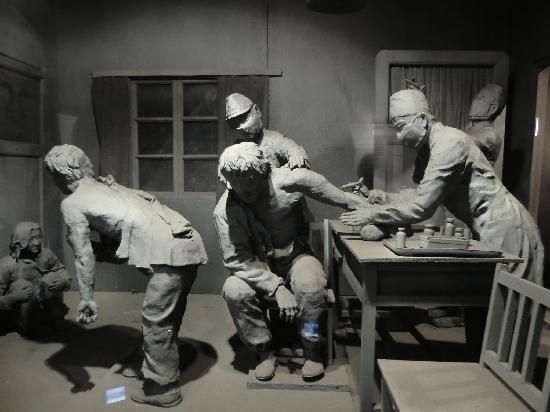In the quest to discover new things, people have indulged in some of the strangest human experiments you could ever imagine.
When people hear the phrase “human experimentation,” they may immediately conjure up images of Frankenstein, the iconic symbol of such practices. However, this is a fictional portrayal rather than a true depiction. In reality, engaging in such grotesque experimentation would have serious and negative consequences.
Conducting human experimentation is both unethical and illegal. Some experiments may subject participants to dangerous materials or emotionally and physically stressful situations, making them susceptible to physical and psychological harm. Below are the 20 strangest human experiments;
20) Operation ARTICHOKE

From 1951 to 1961, the CIA oversaw Operation ARTICHOKE, a program that aimed to investigate the use of hypnosis and other psychological tactics in intelligence gathering and behavior modification.
This initiative was part of the broader MKUltra project, which was launched by the CIA to examine the impacts of psychological manipulation on human subjects. The human experiments carried out was criticised by the public. Operation ARTICHOKE specifically sought to evaluate the effectiveness of hypnosis and other psychological methods in eliciting information from interrogated individuals.
Moreover, it aimed to explore how hypnosis could be utilized in modifying a person’s memory or conduct for clandestine missions. Despite the program’s potential applications, it generated controversy and was eventually terminated due to ethical concerns.
19) Operation Midnight Climax

Operation Midnight Climax was a covert CIA program that took place during the 1950s and 1960s as a component of the broader MKULTRA initiative. CIA agents established secure residences in San Francisco and New York City and enticed unsuspecting men with prost*tutes to visit these locations where they would carry out human experiments on them without their consent.
Once at the safe houses, the men were surreptitiously administered hallucinogenic drugs such as LSD to observe and document the impacts of these substances on their behavior. This unethical experiment persisted until it was publicly revealed in the 1970s, resulting in its termination.
Over the course of its operation, Operation Midnight Climax experimented with a variety of psychedelics on numerous unsuspecting subjects, with the goal of better understanding their effects on human psychology.
18)The Monster Study

In 1939, Wendell Johnson, a psychologist from the University of Iowa, conducted a psychological experiment known as the Monster Study, which aimed to observe the effects of stuttering on orphaned children.
The study involved 22 subjects who were randomly assigned to two groups: one group received positive speech therapy, while the other group was subjected to negative speech therapy. The latter group was exposed to discouraging comments and verbal criticism, resulting in some of them developing speech problems. The human experiments carried out on them would affect them for their rest of their lives.
The experiment has since been regarded as unethical due to the psychological harm inflicted on the children involved and the absence of consent from their legal representatives or guardians.
17) Project MKUltra

Courtesy of the CIA
The CIA’s Project MKUltra was a covert research program conducted during the 1950s and 1960s aimed at developing mind control techniques using drugs, primarily LSD. The program’s goal was to utilize these drugs for intelligence gathering and interrogation purposes.
Despite being officially terminated in 1973, MKUltra remains a highly controversial and debated program due to the unethical and secretive nature of these human experiments. The project’s legacy has revealed disturbing details about the potential exploitation of human subjects for scientific research.
16) The Stanford Prison Experiment

In 1971, Stanford University in California conducted the infamous “Stanford Prison Experiment” to investigate how power and authority affect individuals’ psychology. These human experiments recreated a prison environment, where 24 male participants were randomly assigned to play the roles of either prisoners or guards and were confined to the simulated prison for two weeks.
However, the study had to be terminated prematurely due to the severe emotional distress experienced by the participants, as well as the unethical behavior displayed by the guards. The experiment demonstrated that people tend to conform to social expectations and roles, even when they are abusive and damaging. This study is widely regarded as a classic illustration of the perils of obedience and conformity.
15) Syphilis Experiments in Guatemala

During the 1940s, the US government performed unethical human experiments on s*xually transmitted disease syphilis in Guatemala. These experiments were conducted without the informed consent of the individuals involved and aimed to test the efficacy of penicillin in treating the disease.
14 The Effect of Radiation on Test*cles

In the 1960s and 70s, the University of Washington, on behalf of the US government, conducted a series of human experiments to examine the effects of radiation on US prisoners. Such experiments are considered unethical and unlawful since they cause harm to living organisms.
13 The Milgram Experiments

Stanley Milgram, a psychologist at Yale University, conducted the Milgram experiment in the 1960s, a series of social psychology human experiments. The primary objective of these human experiments was to gauge the extent to which people would comply with an authority figure’s commands, even when such commands conflicted with their conscience.
During the experiments, some participants were falsely led to believe that they would administer electric shocks to others. Despite the shocks being fake, a number of participants, believing them to be genuine, were willing to deliver these shocks to others.
12) Unit 731

Unit 731 was a research unit of the Imperial Japanese Army that conducted human experimentation during World War II, specializing in biological and chemical warfare.
Based in the Pingfang District of Harbin, China, the unit committed some of the most heinous war crimes perpetrated by Japan. The researchers conducted live human experiments on prisoners, including Chinese, Korean, Russian, and Mongolian civilians, and prisoners of war, as they developed and tested biological and chemical weapons.
Although the full extent of the unit’s atrocities remains unknown, it is estimated that thousands of individuals suffered and died due to the cruel treatment they received at the hands of Unit 731.
11) The Stimoceiver Chip

10) Electroshocks on Ch*ldren

9) Infecting Mentally Disabled Children with Hepatitis

Willowbrook State School, located in Staten Island, New York, was a state-funded institution for children with intellectual disabilities that deteriorated in the early 1970s. Reports and investigations revealed that the facility was overcrowded, unhygienic, and inadequately staffed, resulting in conditions that amounted to inhumane treatment.
The reports exposed that Willowbrook staff intentionally infected children with hepatitis as part of an experiment to study the virus’s effects, which was a shocking revelation. This resulted in numerous lawsuits and further investigations, eventually leading to the school’s closure in 1987. Unfortunately, these unethical human experiments at Willowbrook State School forever changed many innocent lives.
8) Nazi Experiments

During World War II, the Nazis conducted brutal experiments on prisoners in concentration camps. These human experiments were carried out without the victims’ consent and were intended to advance the Nazis’ eugenic and genoc*dal goals.
The experiments included freezing trials, high-altitude tests, and exposure to chemical and biological agents. The individuals responsible for these reprehensible acts were tried for war crimes after the war, with many convicted for their atrocities.
It is estimated that over 1,000 prisoners suffered torture and medical procedures as a result of these Nazi experiments, leading to numerous deaths and immeasurable suffering.
7) The Hofling Hospital Experiment

Stanley Milgram conducted the Hofling Hospital Experiment in 1966 to study the effects of authority on human behavior. The experiment involved a nurse, a doctor, and a patient, with the doctor instructing the nurse to administer a potentially lethal dose of medication to the patient.
Despite expressing concerns about the safety of the medication, the nurses complied with the doctor’s orders, exhibiting a remarkable level of obedience to authority. This influential study shed light on the profound impact that authority can have on people’s attitudes and actions.
6) Optogenetics

Optogenetics is a technique used for research purposes, and its primary goal is to study and understand the function of neural circuits in the brain. While it is theoretically possible to use optogenetics to control human behavior, such a use would be highly unethical and illegal.
Additionally, the complexity of human behavior and the brain makes it unlikely that optogenetics could be used in such a manner in the foreseeable future. It is important to emphasize that optogenetics should only be used for scientific research, with ethical considerations always being a top priority.
5) Radio Frequency Identity Chips

An RFID chip is a type of computer chip that can be embedded in people, animals, or objects to track and identify them using radio frequency waves. These chips can also store data, making them useful for a range of applications.
The first instance of an RFID implant in a human occurred in 1998. When implanted in humans, RFID chips can be used to monitor their movements and whereabouts, providing a means of continuous tracking and identification.
4) TGN1412 Drug Trial

The TGN1412 drug trial was carried out in 2006 to investigate the effectiveness of a new immunomodulatory agent, TGN1412, in treating autoimmune diseases and leukemia.
Unexpectedly, all six healthy volunteers who received the drug experienced acute systemic inflammatory response syndrome and multiple organ failure, putting their lives in danger. The trial had to be terminated immediately, and emergency medical treatment was required to save their lives.
Fortunately, the volunteers were able to recover fully with no lasting effects, thanks to prompt medical attention.
3) Tuskegee Syphilis Study

The U.S. Public Health Service conducted the Tuskegee Syphilis Study between 1932 and 1972 in Tuskegee, Alabama. The study aimed to observe the natural progression of untreated syphilis in poor, rural black men with the disease.
Despite the availability of penicillin as a cure for syphilis in the 1940s, the men were not informed of their condition nor treated for it. The study is widely considered an egregious example of unethical medical research and racism in the United States.
In response to the Tuskegee Syphilis Study, changes were made to clinical research practices, such as the development of informed consent guidelines and the establishment of Institutional Review Boards to oversee ethical conduct in clinical research.
2) Mustard Gas Tested on Soldiers

Mustard gas is a chemical weapon that was used in World War I and World War II. It is a powerful vesicant that can cause severe skin, eye, and respiratory irritation and blistering. During World War I, the United States military tested mustard gas on its soldiers to access its effectiveness as a weapon.
Sadly, the soldiers who were exposed to mustard gas suffered significant injuries and long-term health problems. These soldiers were unaware of the human experiment’s potential dangers, and their health was put at risk without their informed consent.
1 Releasing Infected Mosquitoes.

In the 1950s, the U.S. Army conducted experiments involving the release of millions of mosquitoes infected with dengue and yellow fever in Avon Park, Florida, and Savannah, Georgia. These human experiments aimed to explore the potential for mosquitoes to spread these diseases as a form of biological warfare.
Unfortunately, these experiments resulted in numerous individuals becoming ill, and several even losing their lives due to the unethical nature of the experiments.
